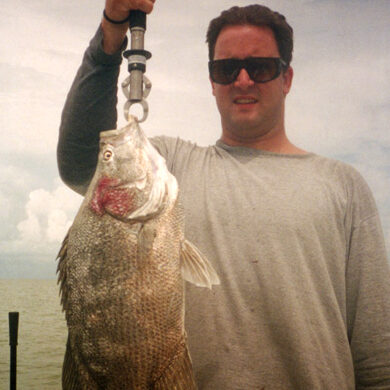The Herald
Sunday, September 1, 2002
Habits of the finicky fish hard to explain
By Susan Cocking
[email protected]
Ariel Cabrera was wade-fishing in Snapper Creek Canal near South Miami when he saw a funny-looking leaf floating by. He poked it with the tip of his fishing rod, and it darted underwater. It was a fish trying to look like vegetation.
So began the part-time Miami fishing guide’s fascination with the tripletail.
“They lure you in,” Cabrera, 27, said. “The mystery.why do they do this and that?”
That’s the same question fisheries scientists like Jim Franks of the University of Southern Mississippi’s Gulf Coast Research lab have been asking for years. And they have surprisingly few answers.
“A big mystery,” Franks said, echoing Cabrera. “But we’re working on it.”
Named for its caudal, dorsal, and anal fins coming together, the tripletail is found throughout the Gulf of Mexico and off Florida’s east coast. For reasons no one knows, large ones in the 40-pound-plus range have been caught along with Space and Treasure coats. On Florida’s lower-east coast, most tripletail are found during dolphin fishing excursions well offshore.
Cabrera frequently encounters tripletail in the summer months near flamingo, floating on the surface with the incoming tide in Cochie Channel and around Cape Sable, trying to blend in with mats of grass. Usually, a mottled brownish-gray, tripletail can change color to match their surroundings. Although Cabrera finds fish in the 3 to 10-pound range at Flamingo, Franks finds dime-sized tripletail around weed patches in the northern Gulf.
“We know they’re being spawned around here, and we think the spawning is in the open Gulf, but we don’t know,” Franks said.
Franks catches his tripletail in nets for spawning experiments. He has raised them in tanks but cannot get them to spawn in captivity. Cabrera and his charter customers catch them using shrimp on popping corks, and he also is successful with small brown flies that imitate shrimp and crabs.
Baked, broiled, fried, or sautéed, tripletail have a mild, delicious taste similar to grouper. If anglers understood their movements better, the species would be subject to overfishing, so Florida imposes a two-fish daily recreational bag limit, a minimum size of 15 inches, and a commercial limit of 10 per boat.
Cabrera said catching tripletail is not as easy as some might think. On a recent charter to Cochie Channel, a customer cast a live shrimp on an Equalizer to a floating tripletail estimated at 10 pounds. The fish appeared to dive down to eat the shrimp, but there was no significant strike, and the fish was never seen again. To Cabrera – a fourth-grade teacher with a master’s degree in science education – this was unbearable.
“Why?” he asked of the fish’s finickiness. “This is going to bother me all night.”


